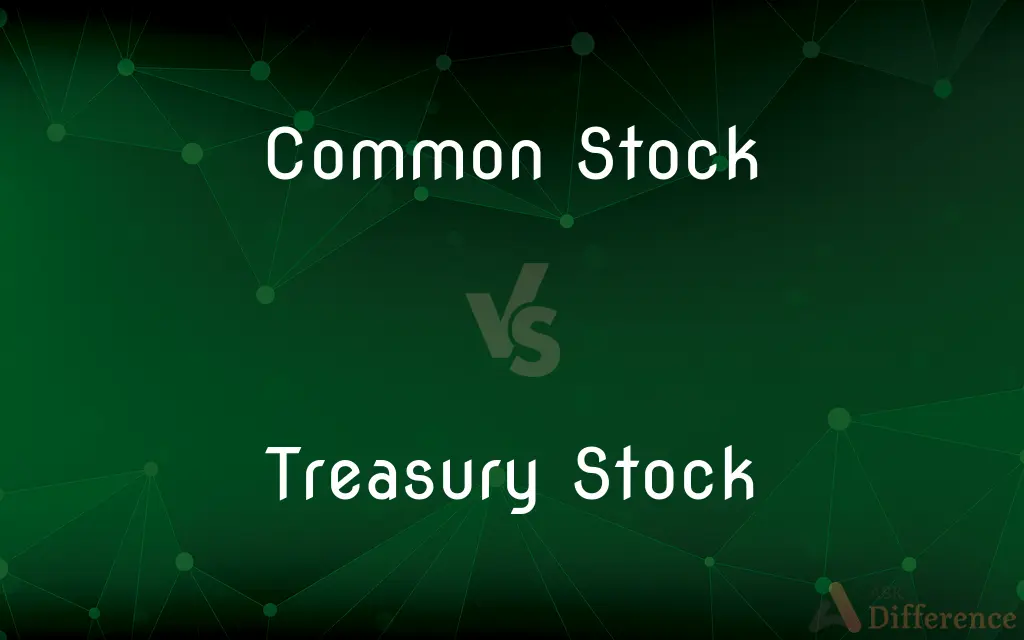Common Stock vs. Treasury Stock — What's the Difference?
By Tayyaba Rehman — Published on October 6, 2023
Common Stock represents ownership in a company with voting rights, while Treasury Stock consists of shares a company has bought back and holds in its treasury.

Difference Between Common Stock and Treasury Stock
Table of Contents
ADVERTISEMENT
Key Differences
Common Stock is a type of equity ownership in a corporation, granting holders voting rights at shareholder meetings and the right to receive dividends. Investors who purchase Common Stock essentially buy a piece of the company, and their ownership stake is proportional to the amount of stock they own relative to the total number of shares available. Such stocks represent a claim on a portion of the company’s assets and earnings.
In contrast, Treasury Stock refers to shares that were once a part of the outstanding shares available in the open market but were later repurchased by the issuing company. It’s worth noting that Treasury Stock is held in the company’s treasury and is not considered when calculating dividends or earnings per share because these shares are not available to the public and don’t have voting rights.
Holders of Common Stock stand to gain from any rise in the company’s stock price or profitability. These investors have the potential to reap dividends, although the amount is not fixed and can fluctuate based on the company’s performance and dividend policy. Common Stock offers the advantage of potentially high returns but also comes with the risk, particularly if the company underperforms.
On the other hand, Treasury Stock holds no such benefit for investors as these shares do not receive dividends nor have voting rights in shareholder meetings. Companies might buy back shares as Treasury Stock to use them for employee incentive programs or to reduce the number of outstanding shares, thereby potentially increasing the stock’s value. It doesn't directly offer a return on investment to the holders.
Common Stock is vital for investors looking for a stake in a company, an avenue for potential profit, and a say in the company’s major decisions via voting. The value of Common Stock fluctuates based on market dynamics and the performance of the company, making it a variable investment that can offer either gains or losses.
ADVERTISEMENT
Conversely, Treasury Stock represents a company’s strategy in managing its own shares in the market. Treasury Stock can impact the price of a company's stock by altering the number of shares available in the market, which can make existing shares more scarce and potentially more valuable if demand remains steady. It's a strategy often employed to return cash to shareholders without paying dividends.
Comparison Chart
Ownership and Voting
Grants ownership and voting rights
Does not provide ownership or voting rights
Dividends
Can receive dividends
Does not receive dividends
Market Availability
Available to investors in the open market
Not available to investors; held by the company
Use in Company Operations
Not used directly in operations
Can be used in employee incentive programs
Impact on Earnings Per Share
Included in earnings per share calculations
Excluded from earnings per share calculations
Compare with Definitions
Common Stock
An equity investment granting ownership and voting rights in a company.
Investors buy Common Stock to have a voting stake in the corporation.
Treasury Stock
Stock repurchased by the issuing company and held in its treasury.
The company used Treasury Stock for its employee stock option plan.
Common Stock
An equity security in a corporation with a variable return.
As the company thrived, the value of her Common Stock appreciated significantly.
Treasury Stock
Shares held by the issuing company, reducing the total number of outstanding shares.
By holding Treasury Stock, the company could potentially boost its stock value.
Common Stock
A type of share providing a claim on a firm’s earnings and assets.
Common Stock entitles investors to a share of the company’s profit.
Treasury Stock
Shares not included in dividends or earnings per share calculations.
Treasury Stock has no voting rights and doesn’t receive dividends.
Common Stock
Shares that may yield dividends based on the company’s discretion.
He received dividends from his Common Stock when the company performed well.
Treasury Stock
Shares reacquired by the issuing company, reducing the amount of outstanding stock.
The corporation purchased Treasury Stock to manage its stock price.
Common Stock
Stocks granting participation in company decision-making through voting.
By owning Common Stock, she could vote on the firm's pivotal issues.
Treasury Stock
Stock that a company buys back from existing shareholders.
The firm bought Treasury Stock to prevent possible takeover attempts.
Common Curiosities
What is Common Stock?
Common Stock is an equity ownership in a corporation, granting voting rights and potential dividends.
Do Common Stock holders have voting rights?
Yes, Common Stock holders typically have voting rights in company decisions.
Can Treasury Stock be reissued to the market?
Yes, companies can reissue Treasury Stock back into the open market.
How does Treasury Stock emerge?
Treasury Stock arises when a company buys back its own shares from the open market.
How are dividends affected by Common Stock?
Dividends can be distributed to Common Stock holders if declared by the company.
Share Your Discovery

Previous Comparison
Ancestry vs. Parentage
Next Comparison
Homogeneous vs. HeterogeneousAuthor Spotlight
Written by
Tayyaba RehmanTayyaba Rehman is a distinguished writer, currently serving as a primary contributor to askdifference.com. As a researcher in semantics and etymology, Tayyaba's passion for the complexity of languages and their distinctions has found a perfect home on the platform. Tayyaba delves into the intricacies of language, distinguishing between commonly confused words and phrases, thereby providing clarity for readers worldwide.











































